Nursing Care Plan: Analyzing Stroke Risk in Mr. Tomasi Joni
VerifiedAdded on 2022/10/19
|11
|1267
|467
Presentation
AI Summary
This presentation analyzes the case study of Mr. Tomasi Joni, focusing on his potential risk of stroke. It utilizes the Levett-Jones’ (2018) Clinical Reasoning Cycle to assess the patient's situation, collect and process information, identify the problem, establish goals, and take action. The presentation highlights Mr. Joni's medical history, including hypertension, gout, and obstructive sleep apnea, along with his current treatment plan and investigation results, such as high cholesterol and fasting glucose levels. The analysis identifies stroke as a potential health complication due to factors like hypertension, obesity, smoking, and family history. The presentation outlines the consequences of stroke and sets goals for treatment, including hypertension and cholesterol control. Interventions such as dietary changes, exercise, and smoking cessation are also discussed. The presentation aims to provide a comprehensive understanding of stroke risk assessment and management in a nursing context.
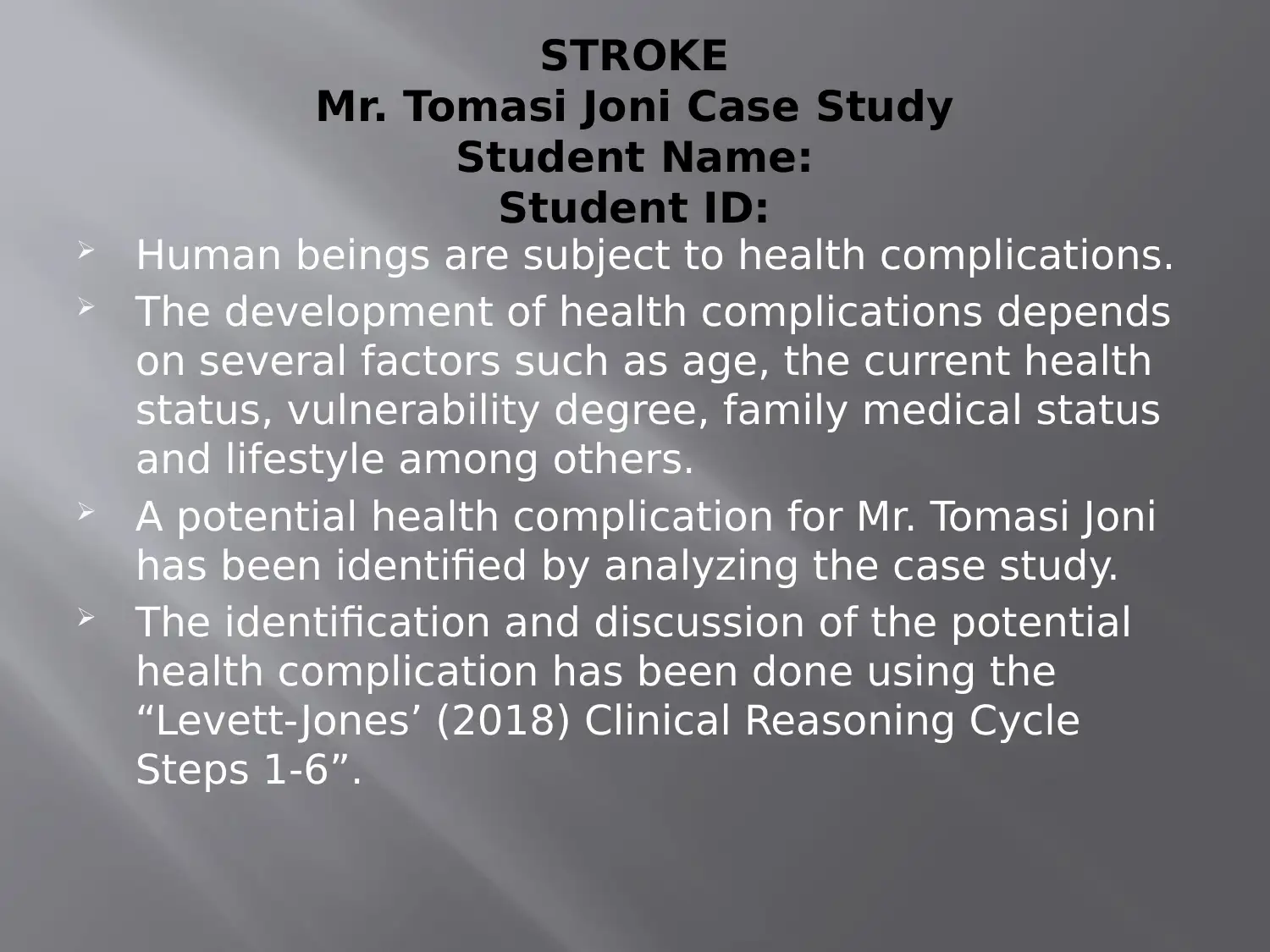
STROKE
Mr. Tomasi Joni Case Study
Student Name:
Student ID:
Human beings are subject to health complications.
The development of health complications depends
on several factors such as age, the current health
status, vulnerability degree, family medical status
and lifestyle among others.
A potential health complication for Mr. Tomasi Joni
has been identified by analyzing the case study.
The identification and discussion of the potential
health complication has been done using the
“Levett-Jones’ (2018) Clinical Reasoning Cycle
Steps 1-6”.
Mr. Tomasi Joni Case Study
Student Name:
Student ID:
Human beings are subject to health complications.
The development of health complications depends
on several factors such as age, the current health
status, vulnerability degree, family medical status
and lifestyle among others.
A potential health complication for Mr. Tomasi Joni
has been identified by analyzing the case study.
The identification and discussion of the potential
health complication has been done using the
“Levett-Jones’ (2018) Clinical Reasoning Cycle
Steps 1-6”.
Paraphrase This Document
Need a fresh take? Get an instant paraphrase of this document with our AI Paraphraser
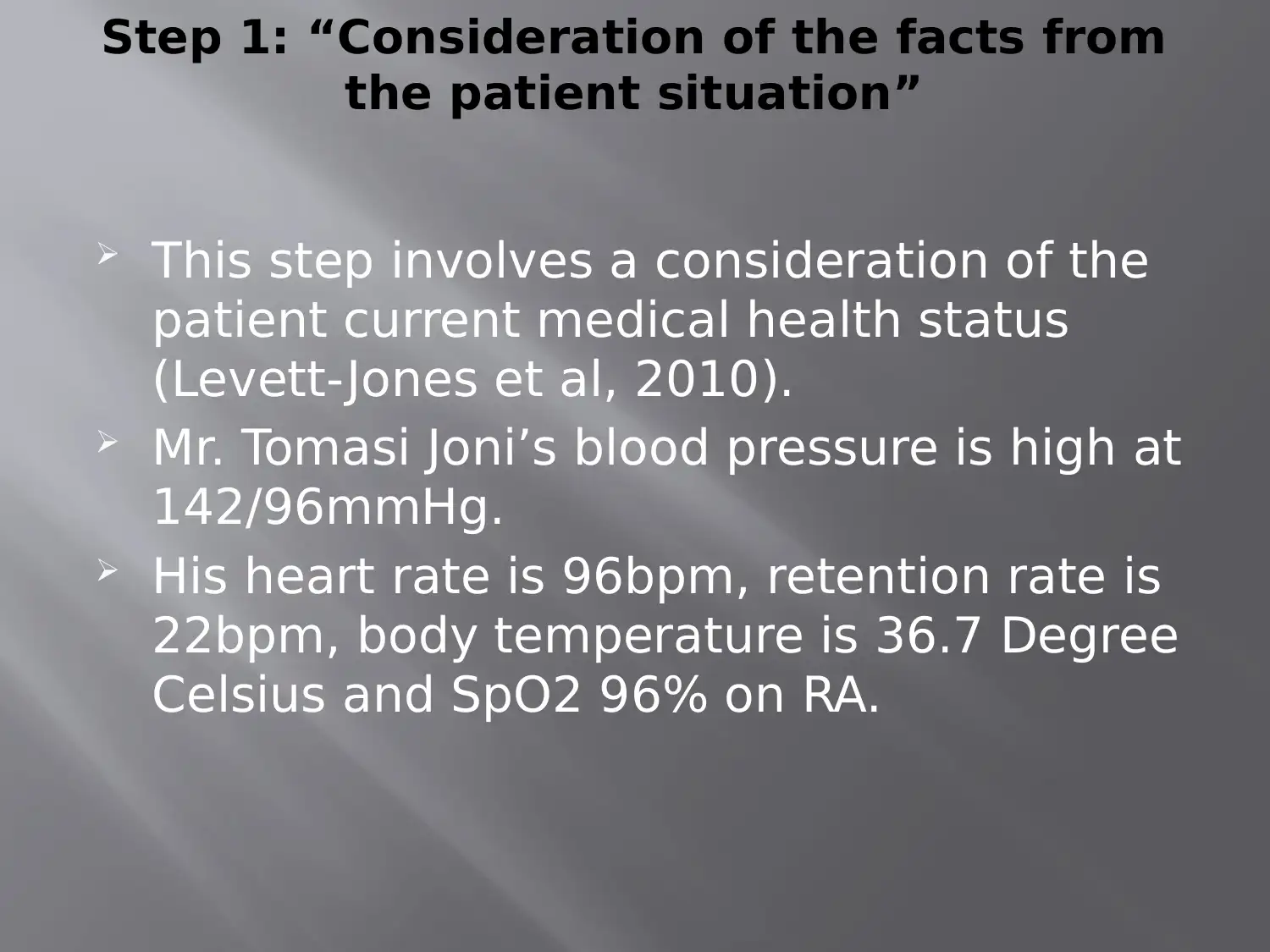
Step 1: “Consideration of the facts from
the patient situation”
This step involves a consideration of the
patient current medical health status
(Levett-Jones et al, 2010).
Mr. Tomasi Joni’s blood pressure is high at
142/96mmHg.
His heart rate is 96bpm, retention rate is
22bpm, body temperature is 36.7 Degree
Celsius and SpO2 96% on RA.
the patient situation”
This step involves a consideration of the
patient current medical health status
(Levett-Jones et al, 2010).
Mr. Tomasi Joni’s blood pressure is high at
142/96mmHg.
His heart rate is 96bpm, retention rate is
22bpm, body temperature is 36.7 Degree
Celsius and SpO2 96% on RA.
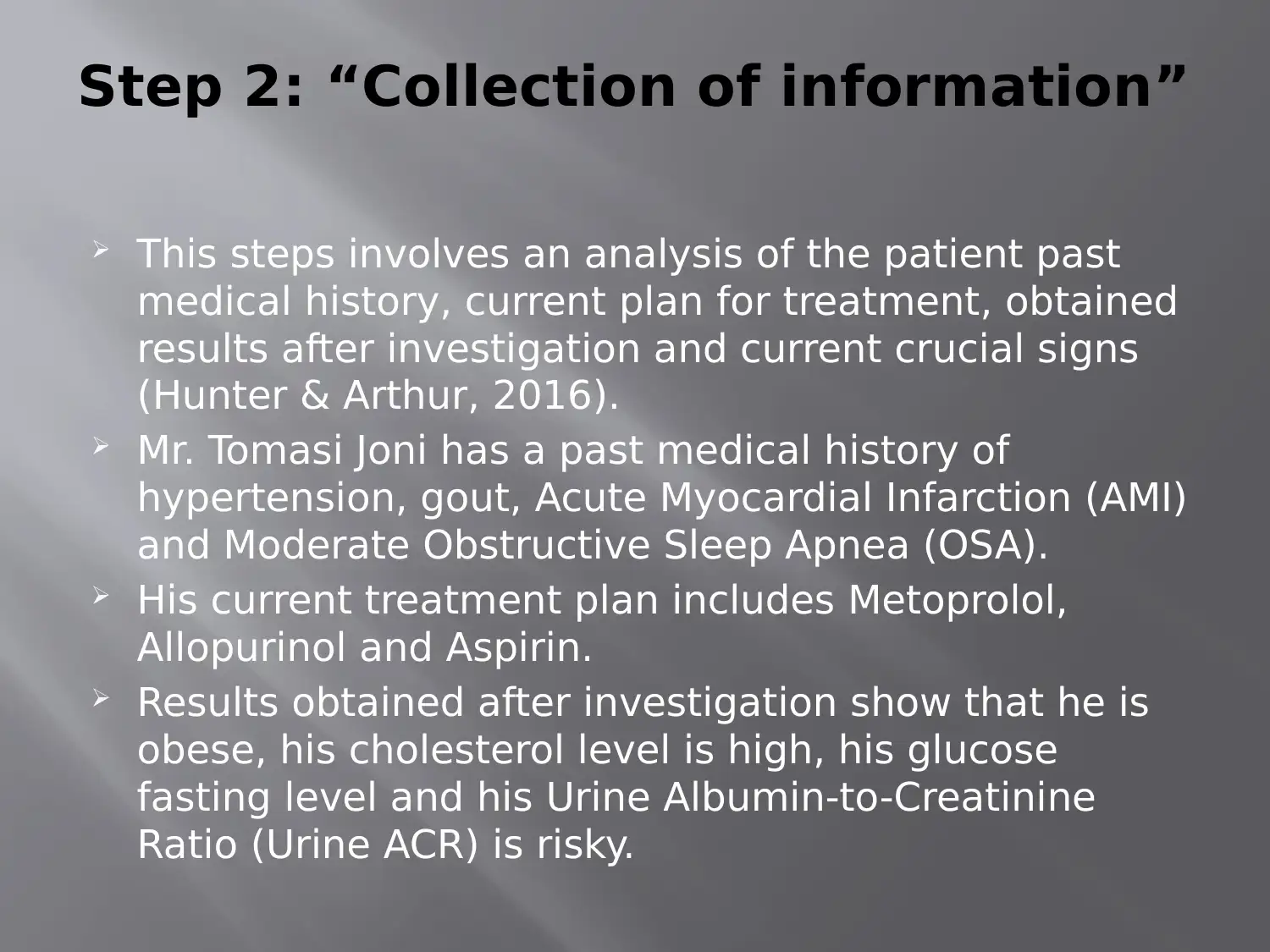
Step 2: “Collection of information”
This steps involves an analysis of the patient past
medical history, current plan for treatment, obtained
results after investigation and current crucial signs
(Hunter & Arthur, 2016).
Mr. Tomasi Joni has a past medical history of
hypertension, gout, Acute Myocardial Infarction (AMI)
and Moderate Obstructive Sleep Apnea (OSA).
His current treatment plan includes Metoprolol,
Allopurinol and Aspirin.
Results obtained after investigation show that he is
obese, his cholesterol level is high, his glucose
fasting level and his Urine Albumin-to-Creatinine
Ratio (Urine ACR) is risky.
This steps involves an analysis of the patient past
medical history, current plan for treatment, obtained
results after investigation and current crucial signs
(Hunter & Arthur, 2016).
Mr. Tomasi Joni has a past medical history of
hypertension, gout, Acute Myocardial Infarction (AMI)
and Moderate Obstructive Sleep Apnea (OSA).
His current treatment plan includes Metoprolol,
Allopurinol and Aspirin.
Results obtained after investigation show that he is
obese, his cholesterol level is high, his glucose
fasting level and his Urine Albumin-to-Creatinine
Ratio (Urine ACR) is risky.
⊘ This is a preview!⊘
Do you want full access?
Subscribe today to unlock all pages.

Trusted by 1+ million students worldwide
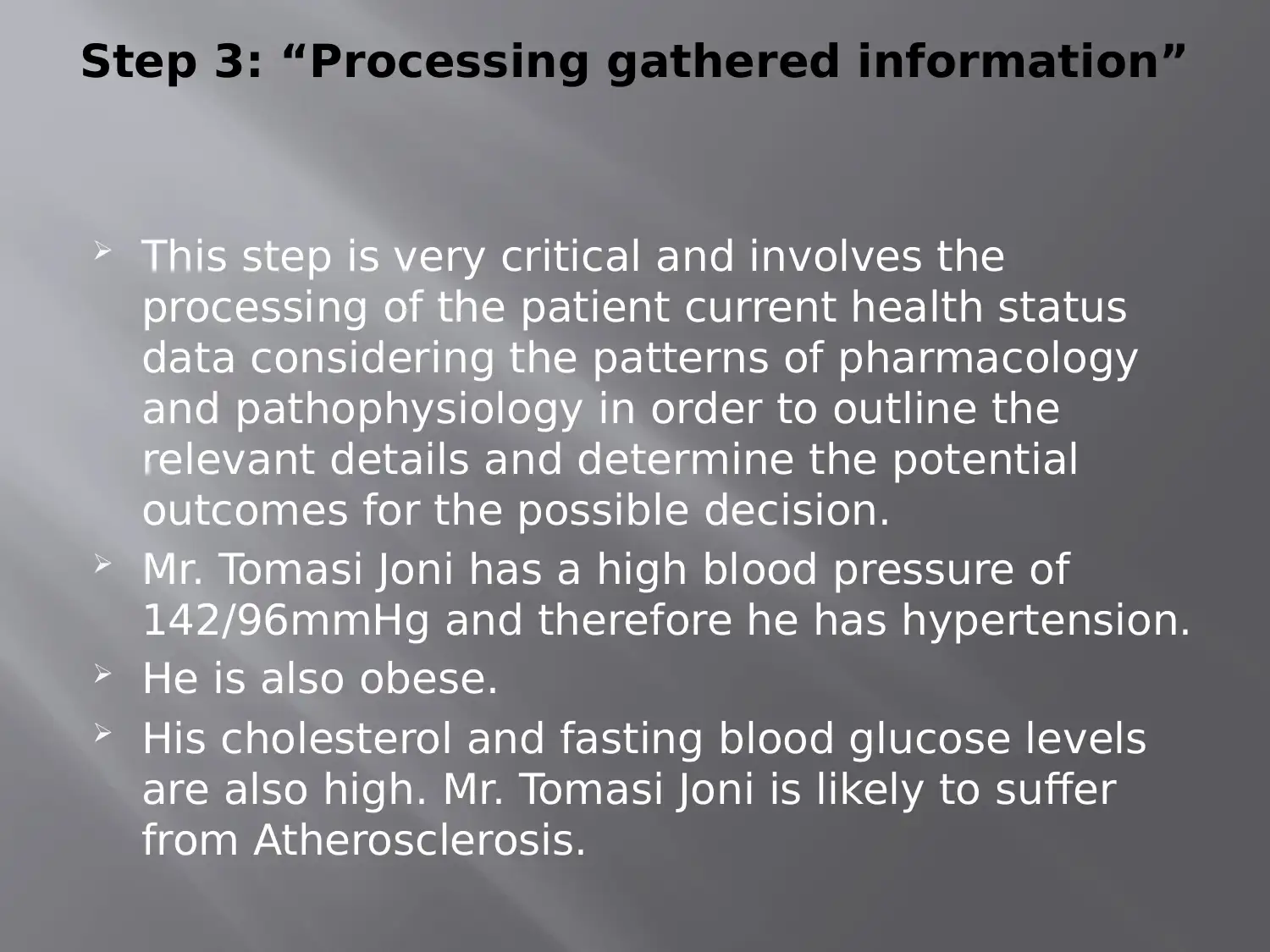
Step 3: “Processing gathered information”
This step is very critical and involves the
processing of the patient current health status
data considering the patterns of pharmacology
and pathophysiology in order to outline the
relevant details and determine the potential
outcomes for the possible decision.
Mr. Tomasi Joni has a high blood pressure of
142/96mmHg and therefore he has hypertension.
He is also obese.
His cholesterol and fasting blood glucose levels
are also high. Mr. Tomasi Joni is likely to suffer
from Atherosclerosis.
This step is very critical and involves the
processing of the patient current health status
data considering the patterns of pharmacology
and pathophysiology in order to outline the
relevant details and determine the potential
outcomes for the possible decision.
Mr. Tomasi Joni has a high blood pressure of
142/96mmHg and therefore he has hypertension.
He is also obese.
His cholesterol and fasting blood glucose levels
are also high. Mr. Tomasi Joni is likely to suffer
from Atherosclerosis.
Paraphrase This Document
Need a fresh take? Get an instant paraphrase of this document with our AI Paraphraser
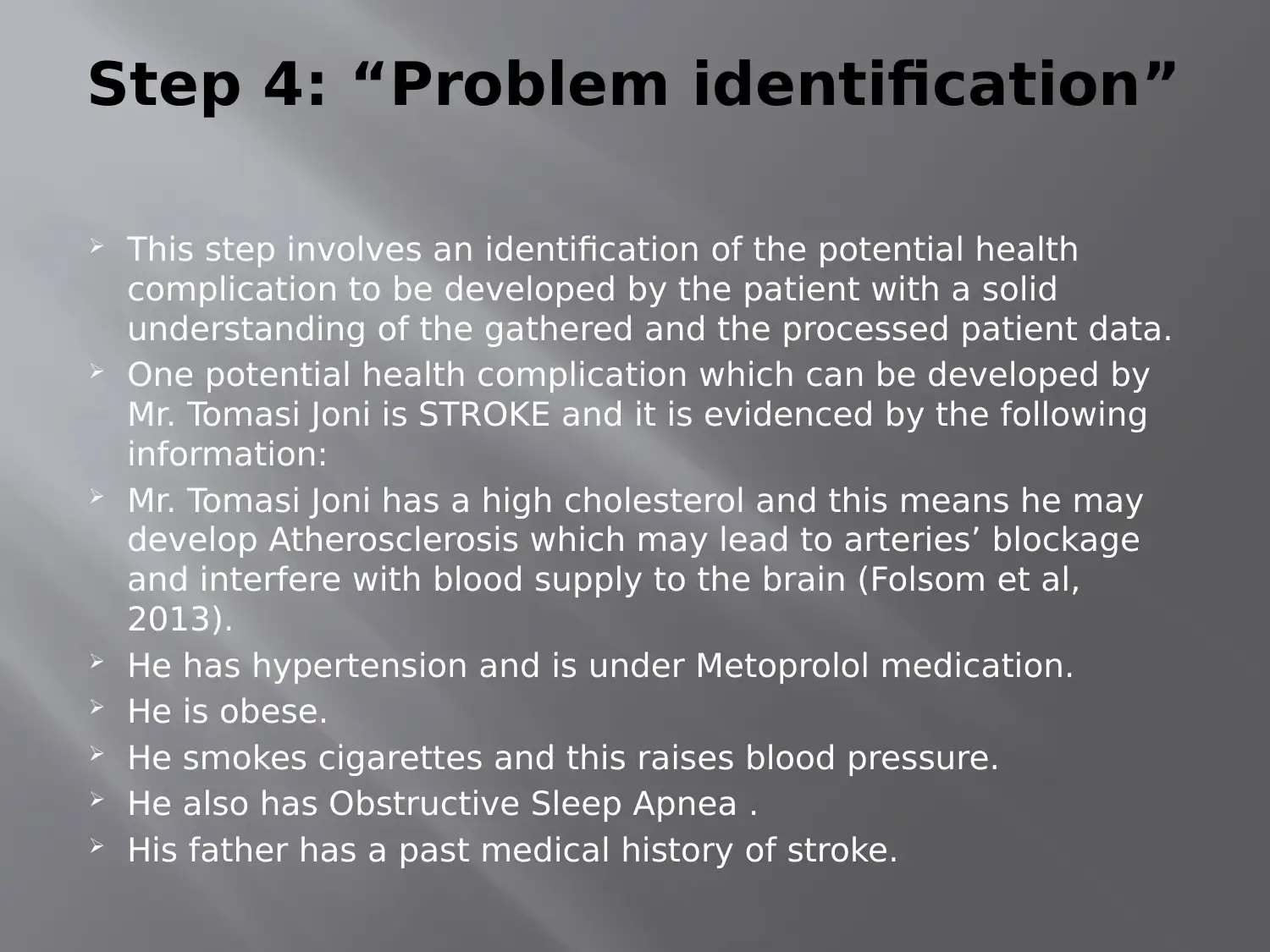
Step 4: “Problem identification”
This step involves an identification of the potential health
complication to be developed by the patient with a solid
understanding of the gathered and the processed patient data.
One potential health complication which can be developed by
Mr. Tomasi Joni is STROKE and it is evidenced by the following
information:
Mr. Tomasi Joni has a high cholesterol and this means he may
develop Atherosclerosis which may lead to arteries’ blockage
and interfere with blood supply to the brain (Folsom et al,
2013).
He has hypertension and is under Metoprolol medication.
He is obese.
He smokes cigarettes and this raises blood pressure.
He also has Obstructive Sleep Apnea .
His father has a past medical history of stroke.
This step involves an identification of the potential health
complication to be developed by the patient with a solid
understanding of the gathered and the processed patient data.
One potential health complication which can be developed by
Mr. Tomasi Joni is STROKE and it is evidenced by the following
information:
Mr. Tomasi Joni has a high cholesterol and this means he may
develop Atherosclerosis which may lead to arteries’ blockage
and interfere with blood supply to the brain (Folsom et al,
2013).
He has hypertension and is under Metoprolol medication.
He is obese.
He smokes cigarettes and this raises blood pressure.
He also has Obstructive Sleep Apnea .
His father has a past medical history of stroke.
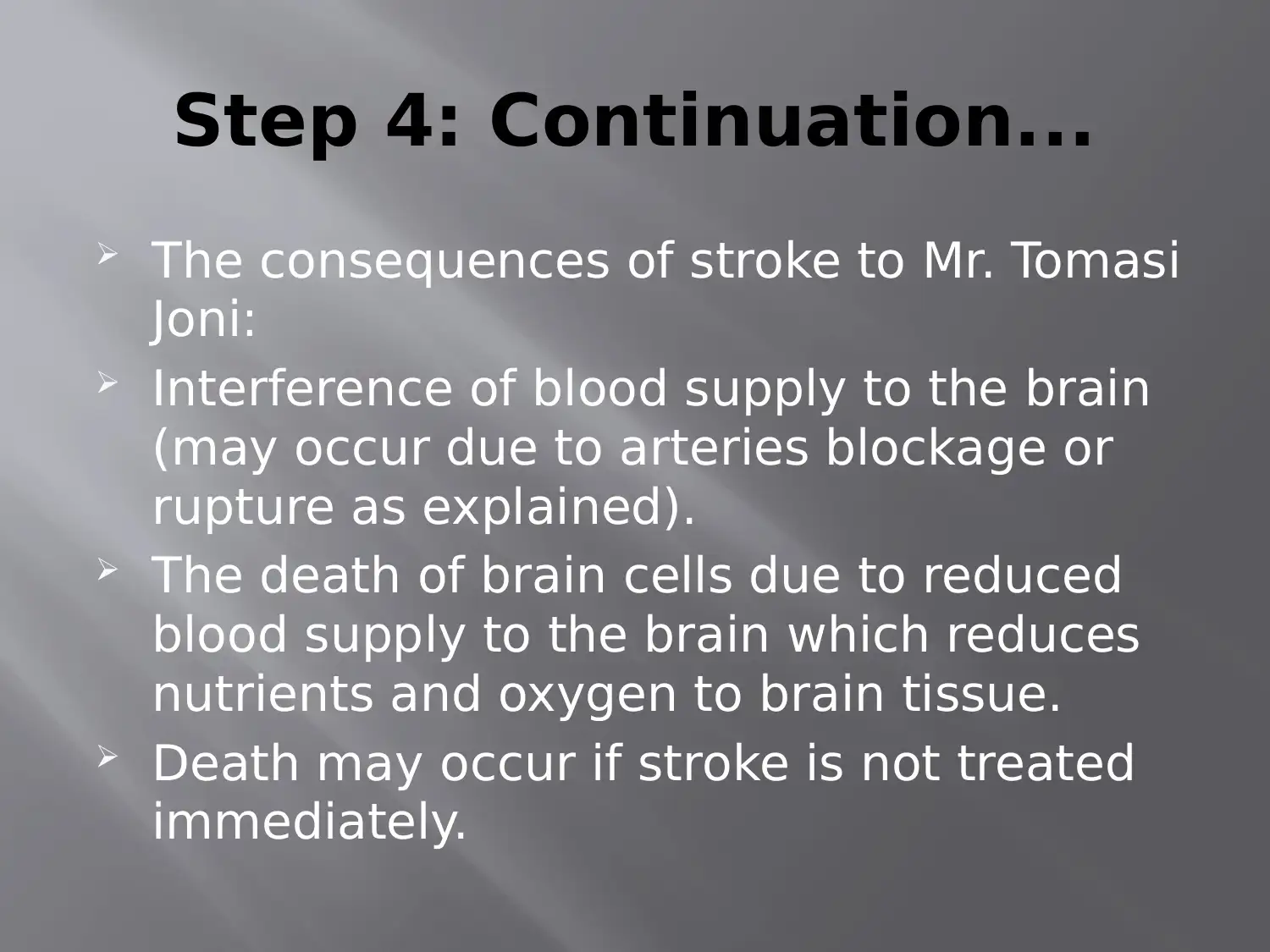
Step 4: Continuation...
The consequences of stroke to Mr. Tomasi
Joni:
Interference of blood supply to the brain
(may occur due to arteries blockage or
rupture as explained).
The death of brain cells due to reduced
blood supply to the brain which reduces
nutrients and oxygen to brain tissue.
Death may occur if stroke is not treated
immediately.
The consequences of stroke to Mr. Tomasi
Joni:
Interference of blood supply to the brain
(may occur due to arteries blockage or
rupture as explained).
The death of brain cells due to reduced
blood supply to the brain which reduces
nutrients and oxygen to brain tissue.
Death may occur if stroke is not treated
immediately.
⊘ This is a preview!⊘
Do you want full access?
Subscribe today to unlock all pages.

Trusted by 1+ million students worldwide
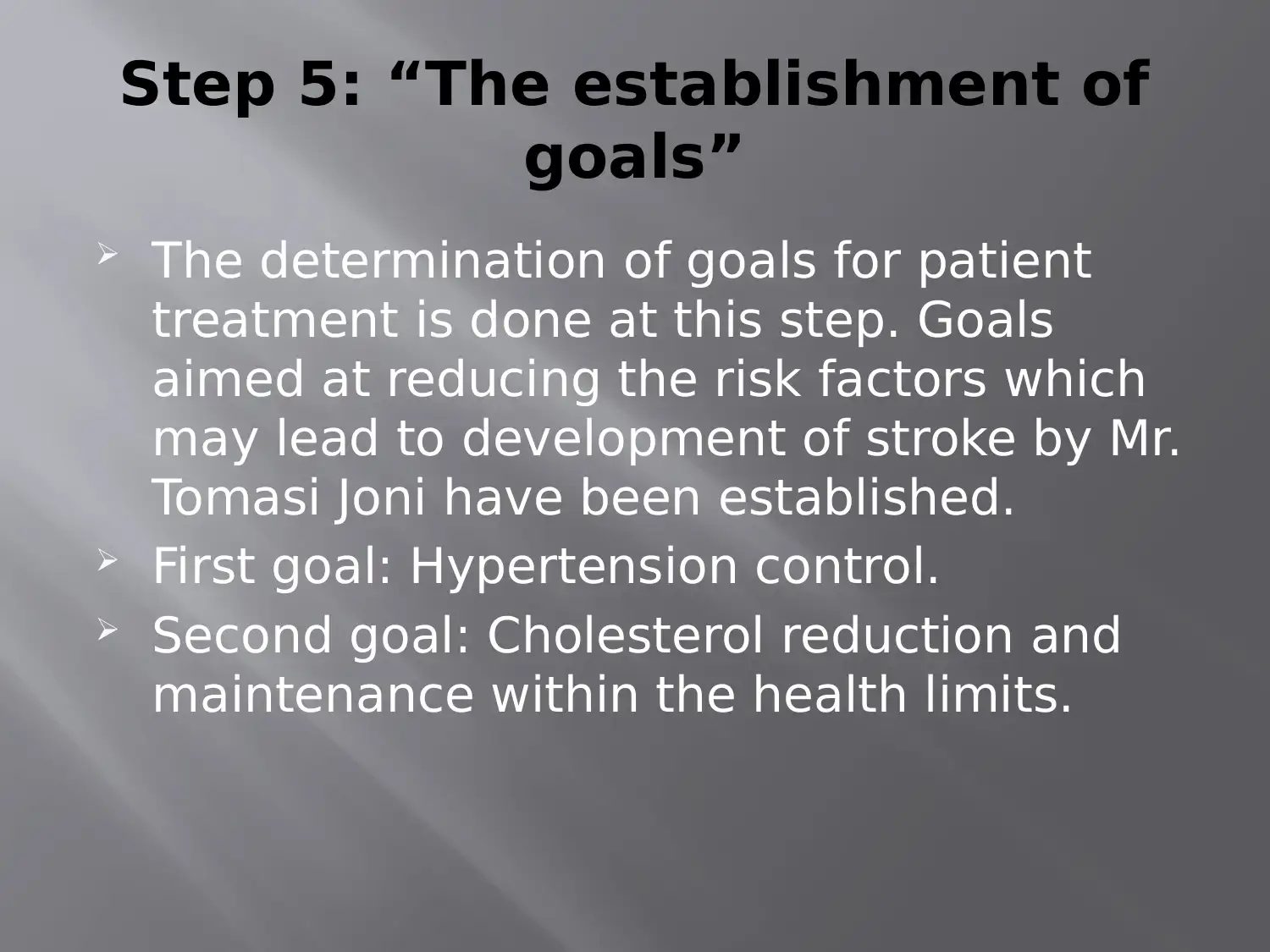
Step 5: “The establishment of
goals”
The determination of goals for patient
treatment is done at this step. Goals
aimed at reducing the risk factors which
may lead to development of stroke by Mr.
Tomasi Joni have been established.
First goal: Hypertension control.
Second goal: Cholesterol reduction and
maintenance within the health limits.
goals”
The determination of goals for patient
treatment is done at this step. Goals
aimed at reducing the risk factors which
may lead to development of stroke by Mr.
Tomasi Joni have been established.
First goal: Hypertension control.
Second goal: Cholesterol reduction and
maintenance within the health limits.
Paraphrase This Document
Need a fresh take? Get an instant paraphrase of this document with our AI Paraphraser
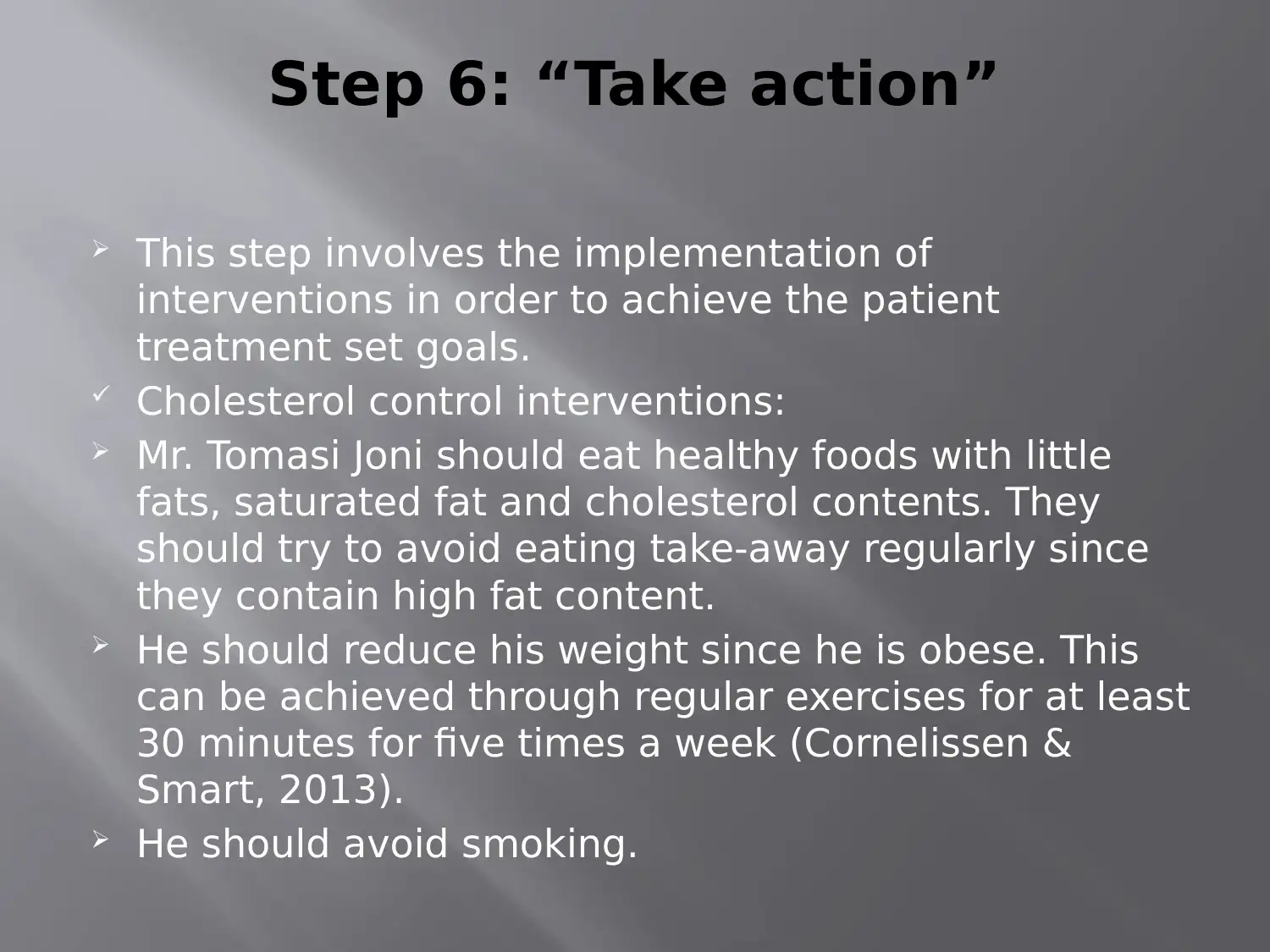
Step 6: “Take action”
This step involves the implementation of
interventions in order to achieve the patient
treatment set goals.
Cholesterol control interventions:
Mr. Tomasi Joni should eat healthy foods with little
fats, saturated fat and cholesterol contents. They
should try to avoid eating take-away regularly since
they contain high fat content.
He should reduce his weight since he is obese. This
can be achieved through regular exercises for at least
30 minutes for five times a week (Cornelissen &
Smart, 2013).
He should avoid smoking.
This step involves the implementation of
interventions in order to achieve the patient
treatment set goals.
Cholesterol control interventions:
Mr. Tomasi Joni should eat healthy foods with little
fats, saturated fat and cholesterol contents. They
should try to avoid eating take-away regularly since
they contain high fat content.
He should reduce his weight since he is obese. This
can be achieved through regular exercises for at least
30 minutes for five times a week (Cornelissen &
Smart, 2013).
He should avoid smoking.
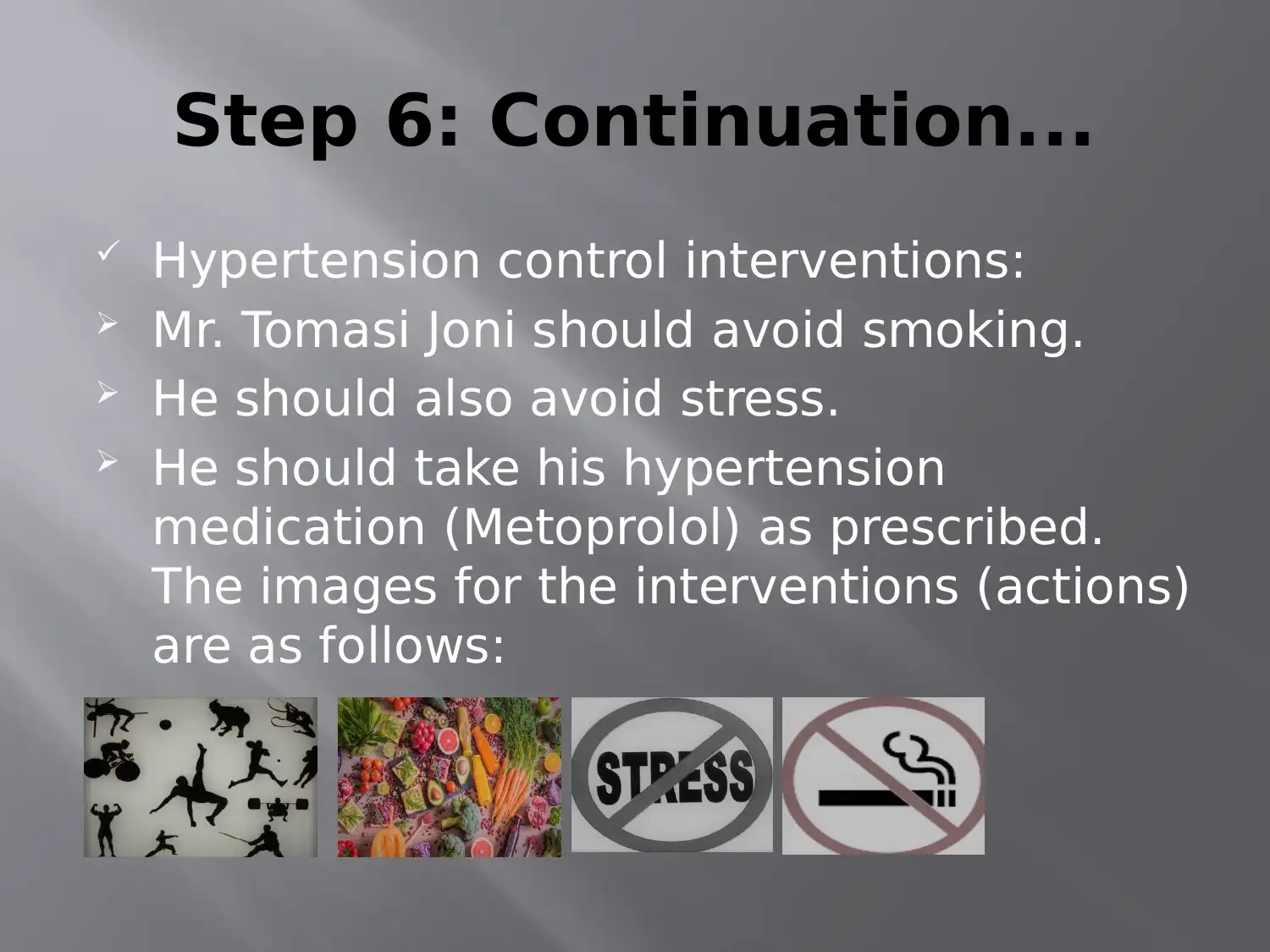
Step 6: Continuation...
Hypertension control interventions:
Mr. Tomasi Joni should avoid smoking.
He should also avoid stress.
He should take his hypertension
medication (Metoprolol) as prescribed.
The images for the interventions (actions)
are as follows:
Hypertension control interventions:
Mr. Tomasi Joni should avoid smoking.
He should also avoid stress.
He should take his hypertension
medication (Metoprolol) as prescribed.
The images for the interventions (actions)
are as follows:
⊘ This is a preview!⊘
Do you want full access?
Subscribe today to unlock all pages.

Trusted by 1+ million students worldwide
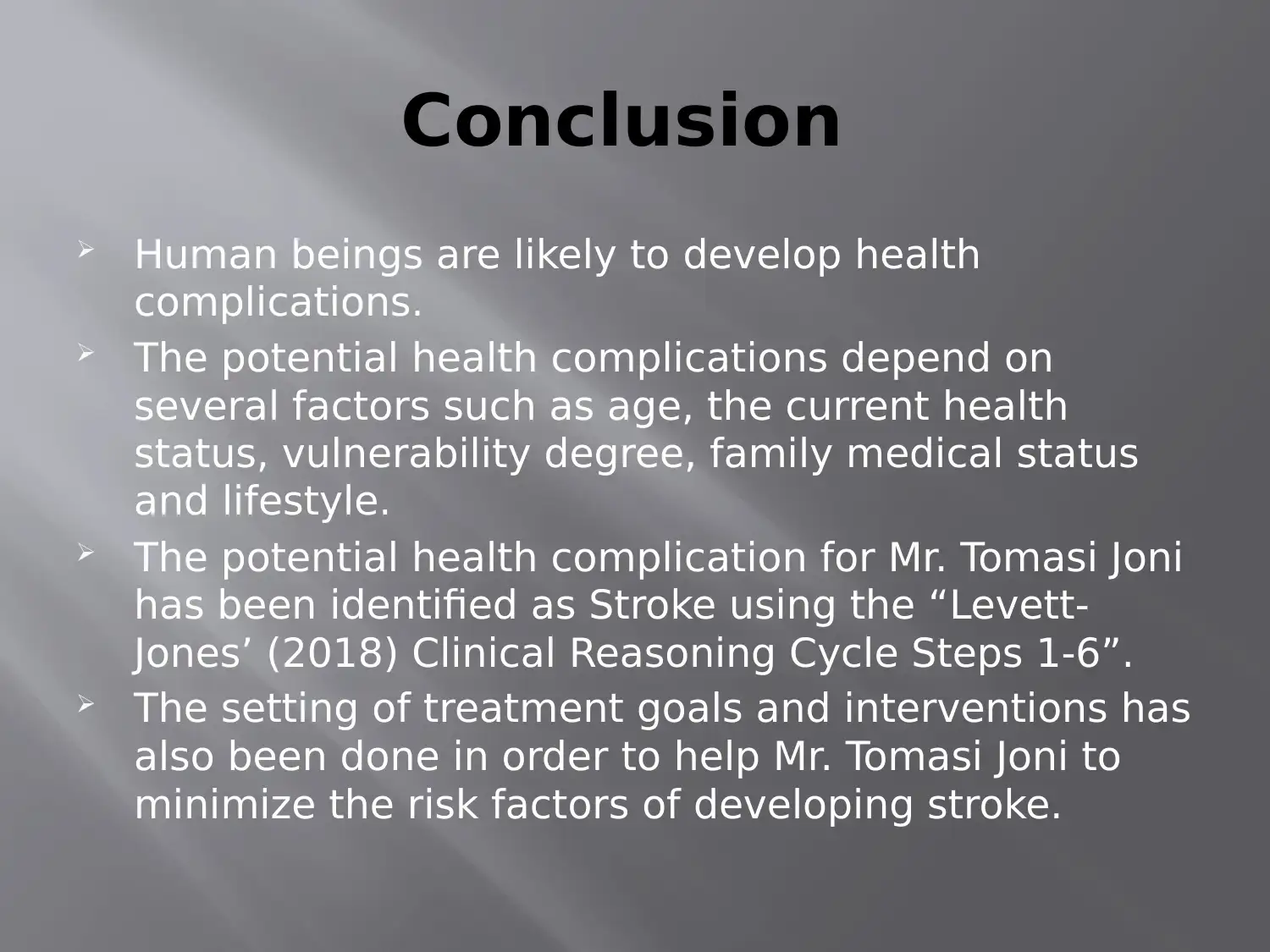
Conclusion
Human beings are likely to develop health
complications.
The potential health complications depend on
several factors such as age, the current health
status, vulnerability degree, family medical status
and lifestyle.
The potential health complication for Mr. Tomasi Joni
has been identified as Stroke using the “Levett-
Jones’ (2018) Clinical Reasoning Cycle Steps 1-6”.
The setting of treatment goals and interventions has
also been done in order to help Mr. Tomasi Joni to
minimize the risk factors of developing stroke.
Human beings are likely to develop health
complications.
The potential health complications depend on
several factors such as age, the current health
status, vulnerability degree, family medical status
and lifestyle.
The potential health complication for Mr. Tomasi Joni
has been identified as Stroke using the “Levett-
Jones’ (2018) Clinical Reasoning Cycle Steps 1-6”.
The setting of treatment goals and interventions has
also been done in order to help Mr. Tomasi Joni to
minimize the risk factors of developing stroke.
Paraphrase This Document
Need a fresh take? Get an instant paraphrase of this document with our AI Paraphraser
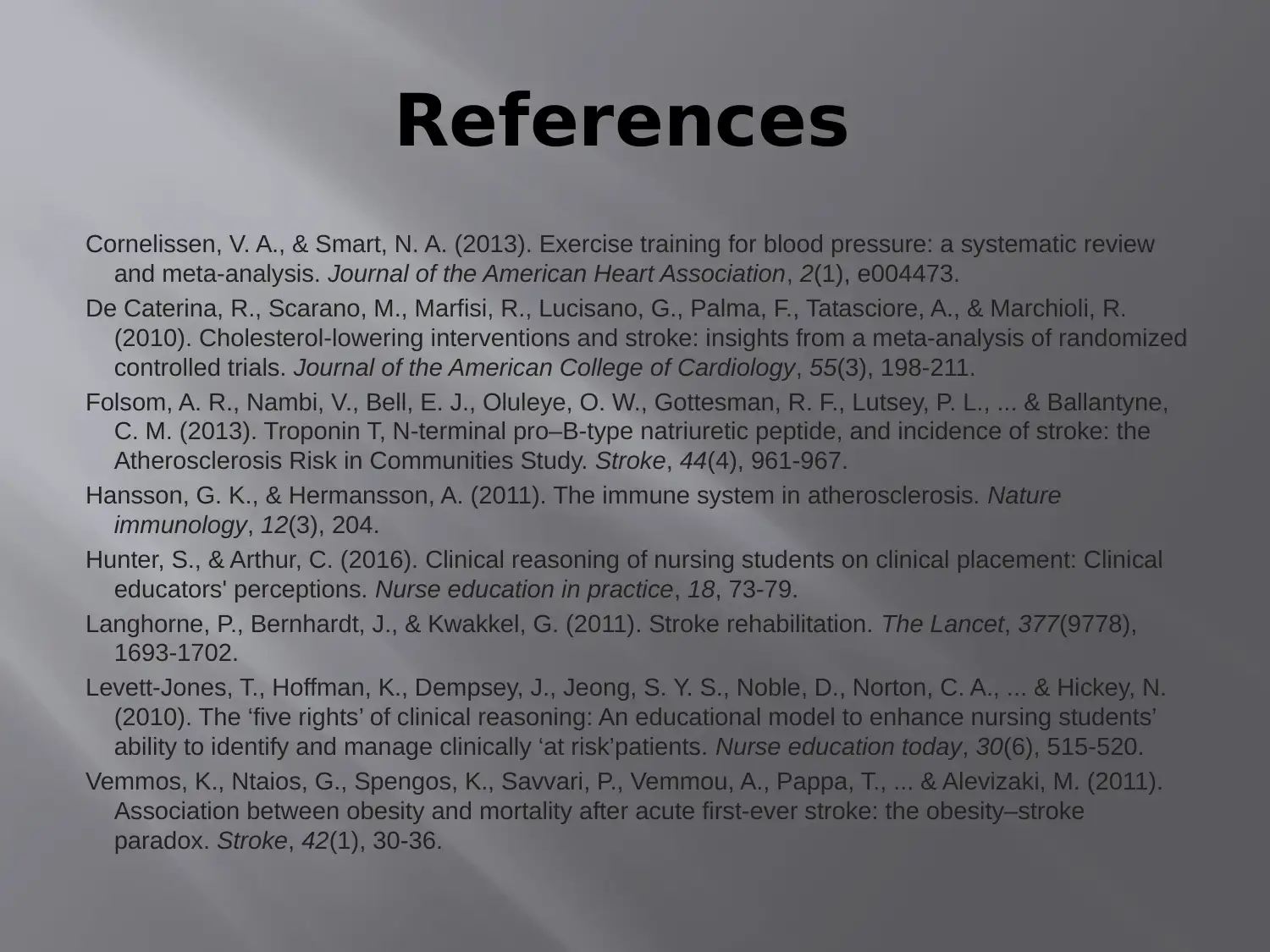
References
Cornelissen, V. A., & Smart, N. A. (2013). Exercise training for blood pressure: a systematic review
and meta‐analysis. Journal of the American Heart Association, 2(1), e004473.
De Caterina, R., Scarano, M., Marfisi, R., Lucisano, G., Palma, F., Tatasciore, A., & Marchioli, R.
(2010). Cholesterol-lowering interventions and stroke: insights from a meta-analysis of randomized
controlled trials. Journal of the American College of Cardiology, 55(3), 198-211.
Folsom, A. R., Nambi, V., Bell, E. J., Oluleye, O. W., Gottesman, R. F., Lutsey, P. L., ... & Ballantyne,
C. M. (2013). Troponin T, N-terminal pro–B-type natriuretic peptide, and incidence of stroke: the
Atherosclerosis Risk in Communities Study. Stroke, 44(4), 961-967.
Hansson, G. K., & Hermansson, A. (2011). The immune system in atherosclerosis. Nature
immunology, 12(3), 204.
Hunter, S., & Arthur, C. (2016). Clinical reasoning of nursing students on clinical placement: Clinical
educators' perceptions. Nurse education in practice, 18, 73-79.
Langhorne, P., Bernhardt, J., & Kwakkel, G. (2011). Stroke rehabilitation. The Lancet, 377(9778),
1693-1702.
Levett-Jones, T., Hoffman, K., Dempsey, J., Jeong, S. Y. S., Noble, D., Norton, C. A., ... & Hickey, N.
(2010). The ‘five rights’ of clinical reasoning: An educational model to enhance nursing students’
ability to identify and manage clinically ‘at risk’patients. Nurse education today, 30(6), 515-520.
Vemmos, K., Ntaios, G., Spengos, K., Savvari, P., Vemmou, A., Pappa, T., ... & Alevizaki, M. (2011).
Association between obesity and mortality after acute first-ever stroke: the obesity–stroke
paradox. Stroke, 42(1), 30-36.
Cornelissen, V. A., & Smart, N. A. (2013). Exercise training for blood pressure: a systematic review
and meta‐analysis. Journal of the American Heart Association, 2(1), e004473.
De Caterina, R., Scarano, M., Marfisi, R., Lucisano, G., Palma, F., Tatasciore, A., & Marchioli, R.
(2010). Cholesterol-lowering interventions and stroke: insights from a meta-analysis of randomized
controlled trials. Journal of the American College of Cardiology, 55(3), 198-211.
Folsom, A. R., Nambi, V., Bell, E. J., Oluleye, O. W., Gottesman, R. F., Lutsey, P. L., ... & Ballantyne,
C. M. (2013). Troponin T, N-terminal pro–B-type natriuretic peptide, and incidence of stroke: the
Atherosclerosis Risk in Communities Study. Stroke, 44(4), 961-967.
Hansson, G. K., & Hermansson, A. (2011). The immune system in atherosclerosis. Nature
immunology, 12(3), 204.
Hunter, S., & Arthur, C. (2016). Clinical reasoning of nursing students on clinical placement: Clinical
educators' perceptions. Nurse education in practice, 18, 73-79.
Langhorne, P., Bernhardt, J., & Kwakkel, G. (2011). Stroke rehabilitation. The Lancet, 377(9778),
1693-1702.
Levett-Jones, T., Hoffman, K., Dempsey, J., Jeong, S. Y. S., Noble, D., Norton, C. A., ... & Hickey, N.
(2010). The ‘five rights’ of clinical reasoning: An educational model to enhance nursing students’
ability to identify and manage clinically ‘at risk’patients. Nurse education today, 30(6), 515-520.
Vemmos, K., Ntaios, G., Spengos, K., Savvari, P., Vemmou, A., Pappa, T., ... & Alevizaki, M. (2011).
Association between obesity and mortality after acute first-ever stroke: the obesity–stroke
paradox. Stroke, 42(1), 30-36.
1 out of 11
Related Documents
Your All-in-One AI-Powered Toolkit for Academic Success.
+13062052269
info@desklib.com
Available 24*7 on WhatsApp / Email
![[object Object]](/_next/static/media/star-bottom.7253800d.svg)
Unlock your academic potential
Copyright © 2020–2025 A2Z Services. All Rights Reserved. Developed and managed by ZUCOL.




